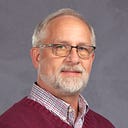
Eckley speaks again through 1986 audio recording
MONMOUTH, Ill. — One of my greatest joys in writing this column is hearing from old timers, who tell me they look forward to reading it every week and some even call me “the new Ralph Eckley.” That’s quite a compliment — to be compared to the beloved local historian whose daily column graced the pages of the Review Atlas for more than a decade, and whose personal knowledge of Warren County history was encyclopedic, having personally lived through nearly nine decades of it.
While I share Ralph’s passion for local history and his commitment to passing it on to future generations, there is one important aspect to Ralph’s legacy that I’ll never be able to match. That realization was underscored recently when I received in the mail from Anne Quinby Dyni of Boulder, Colorado, an audio CD. It contained an oral history that she conducted with Ralph in 1986, three years prior to his death. I was immediately enthralled to hear his voice again, but more important, I was reminded of his incomparable ability to spin a tale. His storytelling prowess was legendary, and his memory for names, dates and historical details was unparalleled. I could listen to him for hours, and often did.
In the recording, Anne, who grew up in the same neighborhood with Ralph and his family, was welcomed into his living room to conduct the interview. Ralph was a young 85, and you could tell from the tone in his voice that relished the opportunity to put down on tape some of the stories from his fascinating life. Most of the interview centered on his personal connections to early aviation history and the significance that Monmouth played in the development of aviation.
In this column, I thought I would relate Ralph’s story from the interview about how the three principal navigation systems for early aviation were developed in Monmouth.
Ralph told about his acquaintance with Matty Laird, who produced the popular Laird Swallow airplane in Wichita, Kansas, in 1922. Laird had working for him three future legends of aviation — Walter Beech, Clyde Cessna and Lloyd Stearman. He said that Laird knew he could sell his planes to customers in Chicago, but there was no easy way at the time to navigate cross-country.
According to Ralph, Laird took his pilots out to the Santa Fe tracks which ran by his plant, and said, “Do you see this double-line track? Simply get up in the air and follow it till you come to a river. That is the Missouri River and on the north side of the river is a flying field. You stop there and buy gas, then follow the same railroad to another river — that’s the Mississippi River and there’s a railroad just across the river. Pay no attention to it go on to the second railroad, turn left five miles and land at Monmouth, Illinois, and get gas again. Then you abandon the Santa Fe railroad and follow the double-track CB&Q railroad into Chicago.”
That was the origin of successful navigation from Wichita to Chicago, Ralph said, and Monmouth was a key point on that route.
Monmouth’s second contribution to navigation, according to Ralph, also occurred in 1922, when an Aledo man named Paul Henderson, who was an assistant postmaster general, was working on ways to develop the national air mail service. He would spend time in Keithsburg along the Mississippi River and noticed that barges navigated by following small flashing lights along the river.
That gave him an idea, and he spent $230,000 installing flashing lights along the route from Clinton, Iowa, to Omaha, Nebraska. Pioneer air mail pilot Jack Knight flew the route, and told a disappointed Henderson that he couldn’t make out a single beacon, because he couldn’t distinguish them from kitchen lights in farmhouses. On his way back to Washington, Henderson stopped at Monmouth to visit Irvin Dains, the president of Western Stoneware, as well as Midwest Airways Corporation. Heading to the CB&Q depot after dinner, Henderson saw a locomotive headlight sweeping the horizon on its route from Kirkwood to Monmouth, and started jumping up and down. It was the inspiration for the rotary beacon, which would be visible to pilots at a distance of 50 miles.
According to Ralph, Henderson thought Monmouth had a reward coming, so in 1925 he made Monmouth headquarters for the developmental division of U.S. Air Mail. To supervise operations, he found an airport manager named Smith In Cheyenne, Wyoming, who had been a World War I pilot and had a science background. He was charged with developing radio navigation for air mail pilots, and according to Ralph, while he was very talented, ‘he couldn’t write for sour apples.” So Ralph ended up writing all the technical papers for the development of the radio beacon. The idea was elegant but simple: One tower would transmit the letter A in Morse code (a dot and a dash), while another tower would transmit the letter N (a dash and a dot). When the signals merged, the pilot would hear a steady hum and was able to stay on course.
It was the third important aviation navigation system to be developed, and all three had a Monmouth connection.
That’s just one of many reminiscences in the oral history. I could go on, but rather than bore you with my retelling, I’ll give you an opportunity to hear it from the inimitable historian’s mouth. Just click on the following link and you’ll be instantly transported to Ralph Eckley’s living room in 1986:
Jeff Rankin is an editor and historian at Monmouth College. He has been researching, writing and speaking about Western Illinois history for more than 35 years.
